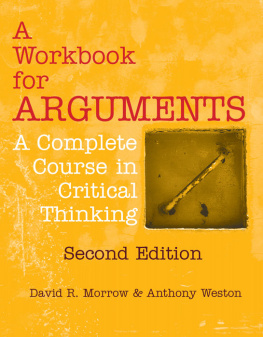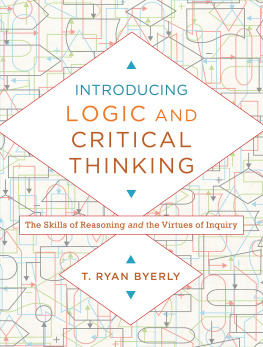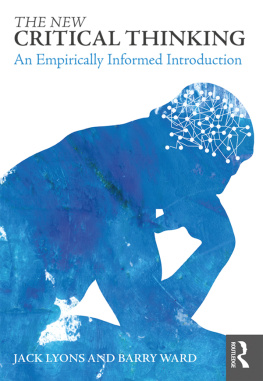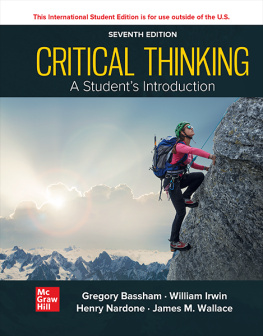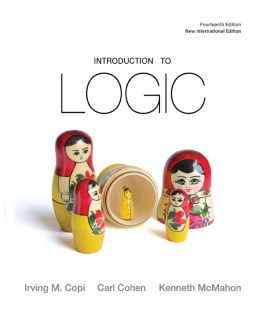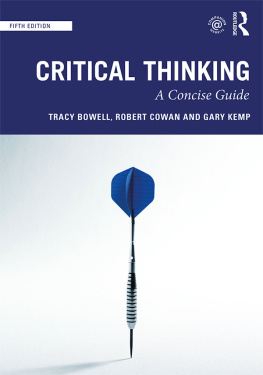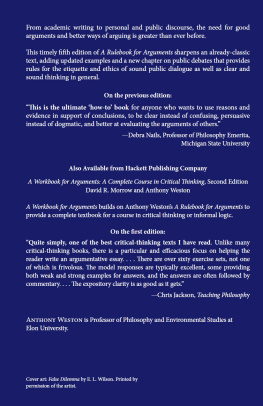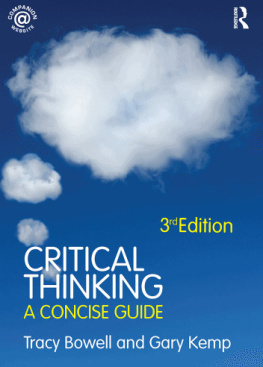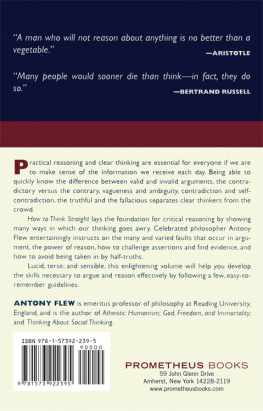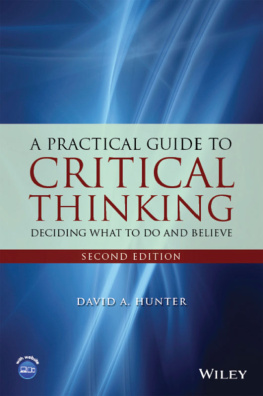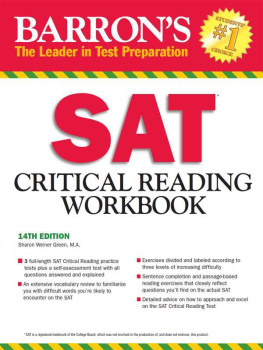A WORKBOOK FOR ARGUMENTS
A Complete Course in Critical Thinking
Second Edition
A WORKBOOK FOR ARGUMENTS
A Complete Course in Critical Thinking
Second Edition
David R. Morrow
&
Anthony Weston
Hackett Publishing Company, Inc.
Indianapolis/Cambridge
Copyright 2016 by Hackett Publishing Company, Inc.
All rights reserved
Printed in the United States of America
19 18 17 16 15 1 2 3 4 5 6 7
For further information, please address
Hackett Publishing Company, Inc.
P.O. Box 44937
Indianapolis, Indiana 46244-0937
www.hackettpublishing.com
Cover design by Deborah Wilkes
Interior design by Elizabeth L. Wilson
Library of Congress Cataloging-in-Publication Data
Morrow, David R.
A workbook for arguments : a complete course in critical thinking / David R. Morrow & Anthony Weston. Second edition.
pages cm
Also contains the entire text of the fourth edition of Westons Rulebook, while supplementing this core text with extensive further explanations and exercises.
Includes index.
ISBN 978-1-62466-427-4 (pbk.) ISBN 978-1-62466-428-1 (cloth)
1. Critical thinking. 2. Reasoning. 3. Logic. 4. Persuasion (Rhetoric)
5. English languageRhetoric. I. Weston, Anthony, 1954 II. Weston, Anthony, 1954 Rulebook for arguments. III. Title.
BF441.M687 2015
168dc23 2015019230
PRC ISBN: 978-1-62466-580-6
Sharon Bailin and Mark Battersby, Reason in the Balance: An Inquiry Approach to Critical Thinking, Second Edition.
George Pullman, A Rulebook for Decision Making.
George Pullman, Persuasion: History, Theory, Practice.
Contents
The page numbers in curly braces {} correspond to the print edition of this title.
Activities for Chapter I
Activities for Chapter II
Activities for Chapter III
Activities for Chapter IV
Activities for Chapter V
Activities for Chapter VI
Activities for Chapter VII
Activities for Chapter VIII
Activities for Chapter IX
Activities for Appendix I
Activities for Appendix II
Activities for Appendix III
{xiii}
A Workbook for Arguments builds on Anthony Westons Rulebook for Arguments to offer a complete textbook for a course in critical thinking. Like the first edition, the Workbook contains the entire text of the fourth edition of the Rulebook while supplementing this core text with extensive further explanations and exercises:
Homework exercises adapted from a wide range of actual arguments from newspapers, philosophical texts, literature, movies, YouTube videos, and other sources.
Practical advice to help students succeed when applying the Rulebooks rules to the examples in the homework exercises.
Suggestions for further practice that outline activities students can do by themselves or with classmates to improve their critical thinking skills or that point them to online resources to do the same.
Detailed instructions for in-class activities and take-home assignments designed to engage students in critical thinking.
An appendix on mapping arguments, a topic not included in the Rulebook, that introduces students to this vital skill in evaluating or constructing complex and multi-step arguments.
Model responses to odd-numbered exercises, including commentaries on the strengths and weaknesses of selected model responses as well as further discussion of some of the substantive intellectual, philosophical, and ethical issues raised by the exercises.
This second edition improves on the first by offering
Updated and improved homework exercises to ensure that the examples continue to resonate with todays students. About one-third of the exercises in the book have been replaced with updated, better tested, or more science-focused examples. The exercises carried over from the first edition have not been changed.
{xiv} An increased focus on scientific reasoning throughout the text, including homework exercises and in-class activities covering a range of scientific disciplines. Nearly every exercise set in the first six chapters includes at least one example of scientific reasoning. (Exercise 5 in each exercise set is a scientific example. See the model responses to Exercise 5 in each set for discussion of scientific reasoning.) The goal of dispersing these examples across the text is to make it clearer to students how scientific reasoning dovetails with critical thinking more generally.
Two new in-class activities that ask students to analyze arguments in their original form, rather than in the simplified form found in the exercise sets. Look for these activities in Part III.
A Rulebook for Arguments will continue to be available in its original brief and slim format, while in this greatly expanded version it can be used as a full-scale textbook in its own right.
The Rulebook first appeared in 1986nearly thirty years ago. When it first came out, we had no idea how much interest there would be in such a book, a little rule-based handbook for argumentation on the model of Strunk and Whites classic The Elements of Style. It turned out there was a great deal of interest! Since then the Rulebook has gone through four editions and has become a bit of a classic itself. It has been used in classes across the curriculum, from high schools and law schools to graduate schools and community colleges, and in the study not just of critical thinking but also of rhetoric, applied ethics, journalism, and many other subjects. It has been translated into ten languagesplus bootlegged into a few moreand even transcribed into braille.
The field of critical thinking has also changed dramatically since the80s. Then commonly called informal logic, at least by philosophers, it was relatively new, still half-wishing to be formal logic and accustomed mainly to treating the wider realm of reasoning as a matter mostly of avoiding fallacies, a grab-bag of seemingly random types of mistakes. Now, by contrast, critical thinking is a field in its own right, much better tuned to the variety and texture of actual argumentation and focused not merely or mainly on pitfalls to be avoided but on the underlying principles of good argumentation. In some small ways, the Rulebook may have helped to forward this wider-angled and more constructive vision of critical thinking. In any case its rules, quite on purpose, represent just such principles.
Rulebook has always been a slim little volume, though: always supplementary, appealing both to writers who want a brief argument handbook {xv} on their shelves alongside The Elements of Style and to students and classroom instructors who need, in the words of the original Preface, a list of reminders and rules a treatment that students can consult and understand on their own and that therefore does not claim too much class time. It has fulfilled that role very well. The Workbook, by contrast, was intended for instructors who wanted to devote more timeor an entire courseto the principles of critical thinking.
The success of the first edition of the Workbook suggests that the field is ready for a full-fledged textbook in the same key as the Rulebook. Here the same rules are laid out, but then systematically elaborated and practiced, first in sets of exercises specific to nearly every rule and then in general exercises keyed to each of the

